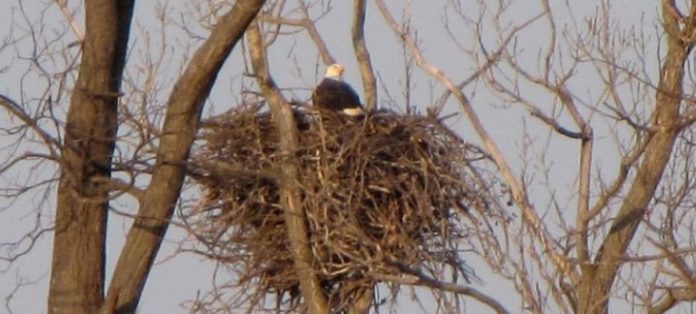by Alison Mitchell, Co-Executive Director, New Jersey Conservation Foundation
As thick snow fell on central New Jersey earlier this week, the bald eagle pair at Duke Farms in Hillsborough showed themselves to be responsible parents-to-be, taking turns keeping the two eggs in their nest warm while the other hunted. When it came time for a shift change, the returning eagle would inch right up against its mate, which carefully stepped aside. Transitions were quick, with barely a snowflake touching the eggs.
If all continues to go well at the Duke Farms nest, two eagle chicks should hatch late this month or in early March, providing a fun and inspirational viewing experience for thousands of fans who visit the organization’s popular Eagle Cam.
The eagle pair at Duke Farms began building their nest in December in the same tall sycamore tree where a nest used for several years collapsed last summer. The first egg was laid in the new nest on Jan. 22 and the second followed on Jan. 25.
Happily for New Jersey, the Duke Farms bald eagles represent only a small fraction of the state’s breeding population. Across this state we’re in, the bald eagle population has been growing since the 1980s, when eagles were on the brink of vanishing from New Jersey because of the pesticide DDT (dichloro-diphenyl-trichloroethane).
Every year, a census of sorts is conducted by the New Jersey Bald Eagle Project, a cooperative effort between the New Jersey Department of Environmental Protection (NJDEP) and the nonprofit Conserve Wildlife Foundation of New Jersey. Staff members and about 150 volunteers monitor known and potential nesting sites to collect data on our national bird’s remarkable recovery in New Jersey.
“We have a lot of eyes and ears out there providing us with information,” said Kathy Clark, supervising biologist of the NJDEP’s Endangered and Nongame Species Program (ENSP).
Little is known about the abundance of bald eagles in New Jersey until the 1950s, when a state study indicated more than 20 pairs were nesting in the Delaware Bay region. That number would plummet as a result of the use of the pesticide DDT, which thinned eggshells and made them too fragile to withstand nesting.
The use of DDT was banned in New Jersey in 1968 and federally in 1972, largely as a result of environmentalist Rachel Carson’s book, “Silent Spring,” which raised concerns about the widespread agricultural use of synthetic pesticides.
Because of residual effects, the DDT ban didn’t bring immediate results. New Jersey’s bald eagles reached their lowest point in the 1970s, when only one breeding pair remained at a nest in Cumberland County. In 1982, after that nest’s thin eggs cracked for six consecutive years, biologists from ENSP stepped in.
They carefully removed the nest’s single egg and artificially incubated it, later returning the hatchling. Artificial incubation and fostering chicks continued with success until 1989, when a younger female took over the nest and the pair was able to hatch their own eggs.
But increasing the production of that one nest in Cumberland County wasn’t enough to boost the state’s bald eagle population. In 1983, ENSP biologists began releasing young eagles from Canada – 60 birds over an eight-year period.
With this jumpstart, the number of active eagle nests in New Jersey began steadily increasing, from four in 1990, to 23 in 2000, to 82 in 2010, to 150 in 2015, to 220 in 2020!
As of 2023, the statewide breeding bald eagle population stood at 286 territorial pairs. Of those, 255 pairs had active nests, producing 309 young. There are now nests in all 21 of the state’s counties, though Cumberland and Salem remain the state’s bald eagle stronghold, with by far the highest concentration of nests.
But bald eagles still face many threats, including human disturbance, habitat loss and contaminants in the food web, including lead from shotgun pellets in deer carrion. Breeding eagles are listed as endangered in New Jersey, while non-breeding eagles are listed as threatened.
Though it’s a thrill to glimpse an eagle soaring overhead, be sure to give nesting eagles plenty of space. The mere presence of people in nesting or foraging areas can cause eagles to change their behavior.
“When eagles change their behavior in reaction to people, they cease doing what is best for their survival and the well-being of their eggs and young,” the 2023 New Jersey Bald Eagle Project report warned. “Ultimately, that can reduce the survival of individuals and the population.”
Yet, eagles are expanding into some of New Jersey’s more urban areas, including the Meadowlands and Hackensack River. According to Clark, they’ve been setting up nests in big trees in older neighborhoods, as well as the edges of industrial sites. “I’m surprised at the nests we’re seeing in old industrial areas,” she said.
Let’s help New Jersey’s eagles keep up their rebound! It’s heartening to see an imperiled species make a comeback, though Clark notes that most of New Jersey’s endangered and threatened species aren’t as resilient as bald eagles.
The ENSP is looking for volunteers to help monitor nests, especially in Salem and Cumberland counties. Being a nest monitor entails checking a specific nest every 1-2 weeks for about an hour at a time, during the nesting season that runs from January through July. The goal is to record key information: when the pair is nest-building, when they lay eggs and begin incubation, when the eggs hatch, and the number of chicks seen and fledged. For more information, email [email protected].
To learn more about bald eagles, go to the Conserve Wildlife Foundation of New Jersey website at www.conservewildlifenj.org/protecting/projects/baldeagle/. Scroll down on the page to download the New Jersey Bald Eagle Project report from 2023 or previous years. To view the Duke Farms Eagle Cam, go to www.dukefarms.org/eagle-cam/.
And to learn more about preserving New Jersey’s land and natural resources, visit the New Jersey Conservation Foundation website at www.njconservation.org or contact me at [email protected].


